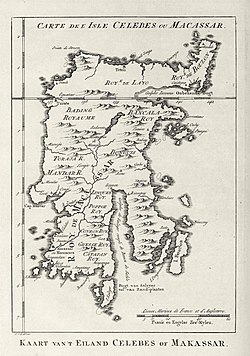Top Qs
Timeline
Chat
Perspective
Bone State
Former country in Indonesia From Wikipedia, the free encyclopedia
Remove ads
Bone (also Boni, or Bone Saoraja) or Bone State was a sultanate in the south-west peninsula of what is now Sulawesi (formerly Celebes), a province of modern-day Indonesia. It came under Dutch rule in 1905, and was succeeded by the Bone Regency.[1]
You can help expand this article with text translated from the corresponding article in Indonesian. (August 2014) Click [show] for important translation instructions.
|
Covering an area of 2,600 square kilometres (1,000 sq mi), Bone's chief town Boni, lay 130 kilometres (81 mi) northeast of the city of Makassar, home to the Bugis people.

Remove ads
History
Summarize
Perspective
Bone was an adat-based Bugis kingdom whose origins can be traced back to the early 15th century. Its chronicle (as yet unpublished) provides detailed information on its rulers, starting from La Umasa, who ruled in the early 15th century, through to La Tenrtatta, who died in 1699. Under La Umasa and his nephew La Saliu (Kerrépelua) who succeeded him, Bone expanded from a handful of settlements around the modern capital Watampone to a small kingdom roughly one-third the size of Kabupaten Bone (the present regency).
In the early 16th century the kingdom expanded northwards, fighting with Luwu for control of the mouth of the River Cenrana, a major east coast trade exit. In 1582 Bone entered an alliance with the Wajo and Soppeng kingdoms for mutual defence against the rising power of Gowa-Tallo. This alliance became known as Tellumpocco'e (lit. the Three Summits) or LaMumpatue Ri Timurung (lit. The burying of the stones at Timurung).[2]

In 1611, during the reign of the tenth king of Bone We Tenrituppu MatinroE ri Sidenreng, Bone was invaded by the Sultanate of Gowa and pressured to convert to Islam.[3][4] Bone State later enjoyed a period of prosperity in the middle of the 17th century.[2]
Bone became the most powerful state of South Sulawesi under Arung (ruler of) Palakka, La Tenritatta (1634 or 1635 – 1696) who sided with the Dutch admiral Cornelis Speelman against the Makasar kingdom of Gowa-Tallo, which led to the defeat and capture of Makassar in 1669. From this year until 1814 when the British temporarily gained power in the region, Bone was by treaty and in practice the overlord of South Sulawesi, with the exception of Dutch-controlled areas on the west and south coast, including the important port-city of Makassar. When the Dutch returned to Makassar in 1816 they attempted to reduce Bone's status from equal to vassal, a move strongly resisted by Bone's rulers.
Over the course of the 19th century, the power of Bone was reduced as a result of several wars waged against it in 1824, 1859 and 1905.[5] Following a military defeat during the South Sulawesi expeditions of 1905, the Bone State lost its independence to the Dutch.[6] Bone, along with Gowa, became under direct administration.[7]
In the late 1920s, the Dutch restored many royal rulers as a way to suppress the tide of nationalist sentiment. Bone was no exception; in 1931, Mappanyuki, a scion of both the houses of Gowa and Bone, was restored to his family's ancestral position in Watampone.[7]
In May 1950, the people held demonstrations in Watampone against the royalty and Bone's membership in the State of East Indonesia. This caused the sultan to join Indonesia.[4]
Remove ads
List of rulers
Summarize
Perspective
Rulers of Bone used the title Arung Mangkaue' ri Bone (the king who resides in Bone), shortened to Arumpone, MangkauE, or ArungE' ri Bone.
Remove ads
See also
Citations
References
Further reading
Wikiwand - on
Seamless Wikipedia browsing. On steroids.
Remove ads


